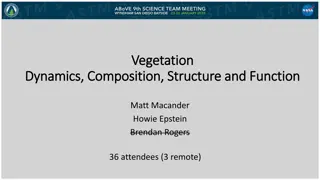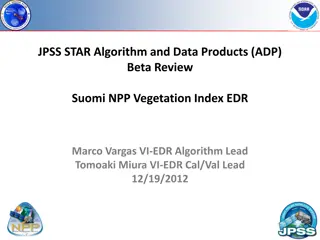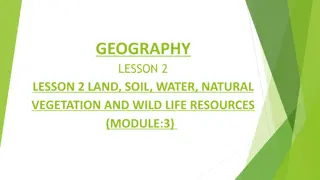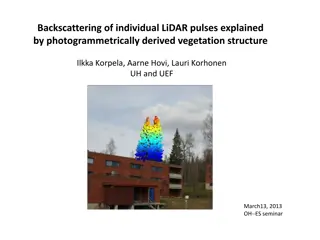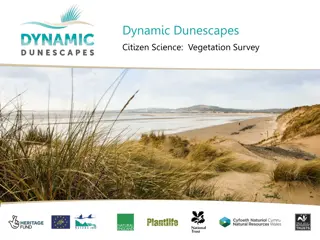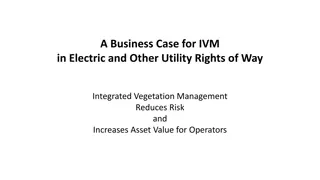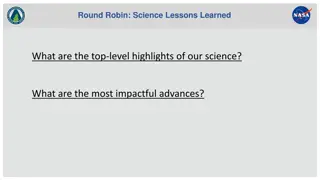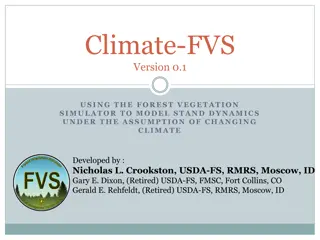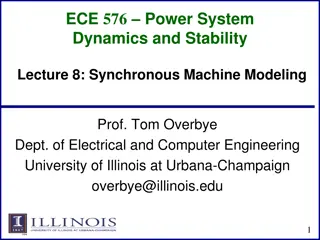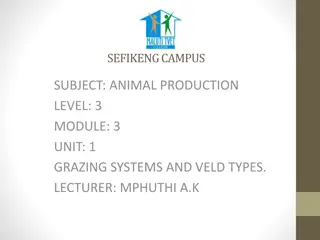Understanding Vegetation Dynamics with LPJ-GUESS Modeling
Explore the modeling of vegetation dynamics using LPJ-GUESS, covering stand to global scale approaches, management needs, and ecosystem-scale considerations. Discover the characteristics of ecosystem-scale modeling and the inputs and outputs of LPJ-GUESS for simulating vegetation dynamics.
Download Presentation

Please find below an Image/Link to download the presentation.
The content on the website is provided AS IS for your information and personal use only. It may not be sold, licensed, or shared on other websites without obtaining consent from the author. Download presentation by click this link. If you encounter any issues during the download, it is possible that the publisher has removed the file from their server.
E N D
Presentation Transcript
Modeling Vegetation Dynamics with LPJ-GUESS KATIE IRELAND, ANDY HANSEN, AND BEN POULTER
Stand to Global Scale Modeling Approaches Stand-scale models Gap (i.e., ZELIG ) Growth-Yield (i.e. FVS) Landscape models Mechanistic - (FireBGCv2) Deterministic (SIMMPLE) Global Models DGVMS (MAPSS)
Need for Management at Large Spatial Scales Fire Insects Disease Climate change Land-use change Need ecosystem-scale science, management Hansen et al. 2011. Bioscience 61:363-373
What do we mean by ecosystem-scale? Cross management boundaries Ecological flows Crucial habitat Effective size Human edge effects Range of sizes ~5500 143,000 km2 contiguous habitat Hansen et al. 2011. Bioscience 61:363-373
Stand to Global Scale Modeling Approaches Stand-scale models Gap (i.e., ZELIG ) Growth-Yield (i.e. FVS) Landscape models Mechanistic - (FireBGCv2) Deterministic (SIMMPLE) Ecosystem-scale models LPJ-GUESS Global Models DGVMS (MAPSS)
Desired Model Characteristics For modeling vegetation dynamics at greater ecosystem scales: Capable of simulating individual species/communities Links climate with ecosystem processes Simulates disturbance Large spatial scale Ex. Yellowstone & Grand Teton Ecosystem ~42,500 km2
Inputs LPJ-GUESS Photosynthesis Respiration Allocation Establishment, growth, mortality, decomposition Climate data: monthly temp., precip., shortwave radiation, CO2 Soil data: soil texture Vegetation: PFT/species, bioclimatic limits, ecophysiological parameters Outputs Vegetation types Biomass Carbon storage C & H20 fluxes NPP, NEE Fire-induced mortality CO2, etc. emissions Fuel consumption
Vegetation Dynamics in LPJ-GUESS GUESS: Individual/Cohort Mode LPJ-DVM: Population Mode PFTs PFTs or species Simplistic veg. Dynamics Gap veg dynamics No cohorts Cohorts Fine Coarse
Bioclimatic Niche Each PFT assigned bioclimatic limits Survive prevailing climatic conditions Variables Tcmin min. coldest month temperature, survival Tcmax max. coldest month temperature, establishment GDDmin min. GDD sum (5oC), establishment Tw-c,min min. warmest coldest month temperature range
Fire Dynamics SPITFIRE model Emissions CO2, CO, CH4, NOx Climate Temp, precip, radiation, CO2 LPJ-GUESS Vegetation pattern Vegetation (type, crown height, length, DBH) Litter (size, moisture, distribution) Plant mortality/damage Wind (speed, direction)
Comparisons: LPJ-GUESS, BIOME-BGC, FireBGCv2 BIOME-BGC Stand to global Biomes (static) FireBGCv2 Landscape Individual tree (dynamic) LPJ-GUESS Stand to global PFTs or species cohorts (dynamic) Monthly climate, soil texture, ecophysiological parameters C, H2O fluxes, vegetation, fire Fire Spatial Scale Vegetation Representation Input Variables Daily climate, ecophysiological parameters Daily climate, site variables, ecophysiological parameters C, N, H2O, vegetation, fire Fire, insects, disease Yes Output Variables C, N, and H2O fluxes Fire Disturbance Spatially interactive No No
LPJ-GUESS & PNV Shifts in Europe By 2085: NCAR-PCM: 31% in different PNV HadCM3: 42% in different PNV Forest replaces tundra Broad-leaved temperate forest expands northward Mediterranean forest shifts to shrubland Hickler et al. 2012 Global Ecology & Biogeography 21: 50-63
LPJ-GUESS for Ecosystem-scale Modeling? Cons Pros Lack of spatial interactions Dispersal Disturbance Parameters for North American tree species Stochastic establishment/mortality Computationally intensive Capable of simulating individual species Species dynamic Large-scale applications Links climate to vegetation change


